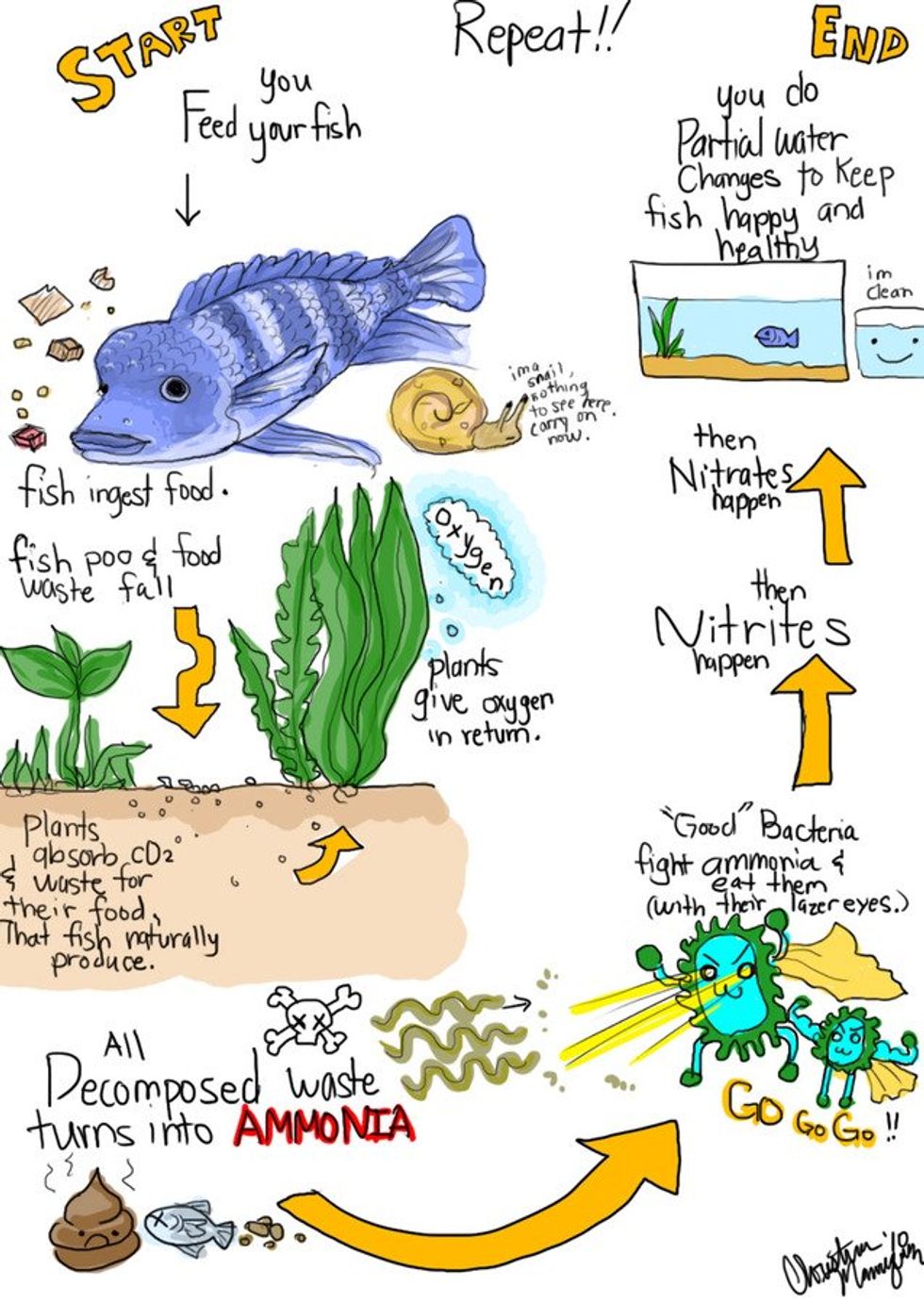Fish care seems pretty simple at first, but walking into a supply store and trying to decide on what kind of equipment to purchase is an entirely different experience. From choosing between different tank sizes, what wattage heater to buy, sponge vs. mechanical filters, and even the plethora of decorations available for a tank, most people overlook a simple but vital concept: the Nitrogen Cycle.
What is the Nitrogen Cycle?
Every fish tank goes through this cycle, which is crucial to learn in maintaining healthy fish. It begins with the waste and byproduct of the fish in the tank, from fecal matter, oxygen the fish metabolizes, and uneaten food. These byproducts are converted into either ammonium (which is harmless) or ammonia, which is very toxic. Fortunately, every tank also grows beneficial bacteria. These bacteria colonies can only grow large enough based on their food source (byproducts from anything the fish produces), oxygen, and the surface area of the tank (the walls, decorations, gravel, plants and the filter in the tank).
Ammonia in the tank is eventually converted into nitrites, which are just as toxic as ammonia. The job of the bacteria is to convert the ammonia into nitrites. The nitrites, in turn, are converted into nitrates, which are less toxic. Then it's a matter of doing partial water changes to remove the remaining toxins from the tank and the cycle repeats itself.
How do I cycle my tank?
Before adding fish to the tank it's important to establish a cycle. By adding a fish (or multiple fish) to a tank there won't be enough beneficial bacteria to convert ammonia and nitrites, causing a massive spike in the tank. This can cause numerous infections such as ick, fin rot, velvet disease, burned gills, and can even kill the fish. An easy way to start a fishless cycle is to use 100 percent pure ammonia. Using a dropper put one or two drops of ammonia and buy a test kit to check for ammonia and nitrite levels. Continue this process daily until nitrate readings begin to show up on the test kit and perform a 30 percent water change. Once this is done the tank is ready to house fish.
Another easy way to begin a cycle is to use a bacteria culture product, which is supposed to colonize the water with bacteria necessary in detoxifying ammonia. Colonize and Tetra SafeStart are two culture products that will work for cycling a tank.
When should I change my water?
It largely depends on how many fish are in the tank, the filtration system, how warm the water is, as well as how large the tank is. A good way to determine when it's time to change the water in the tank is to test the water daily with a test kit. Ammonia and nitrite levels should be less than .25 ppm and optimally at 0 ppm, while nitrates should be under .20 ppm. Once ammonia and nitrite levels begin to rise is when tank water should be changed. So, if it took three days for the levels to rise, that should be the schedule for how frequent the water changes are.
There is a lot of debate on how much water should be changed per week and whether a tank's water should be partially or fully changed. Small changes of 25 percent are the general rule of thumb to remove toxins from the water unless there has been a major spike in toxins that may threaten the life of the fish. By doing a complete water change it removes all of the beneficial bacteria that built up in the tank. Doing a complete water change can also shock the fish due to a drastic change in water parameters (and stress it out from removing it from the tank). It's also important to buy water conditioner, add it to the new water, and let the water sit for 24 hours before doing the water change. The water conditioner is vital because municipalities add chloramines to tap water to decontaminate it. Chloramines are created through a chemical reaction between chlorine and ammonia.
To do a partial water change, simply leave the fish in the tank and siphon the old water out. Once it's removed slowly add the new water in increments so the fish isn't shocked from a change in temperature.
Simple and clean
While the Nitrogen Cycle seems complicated it really comes down to diligence and patience. Once a tank is established it will ensure that the fish is happy and healthy. There's nothing more exciting than bringing a new fish home, but this excitement turns into dread when that fish falls ill or even dies after a week or two. This dread is compounded if multiple fish are added to a tank too quickly and they all fall ill. Doing a fishless cycle, testing the water, and performing partial water changes is simple and will save a lot of time and the precious lives of family fish.
Ever consider buying a betta fish? Click here to find a step by step guide on buying a betta bish, which includes the proper equipment and necessary maintenance in owning a betta.




















